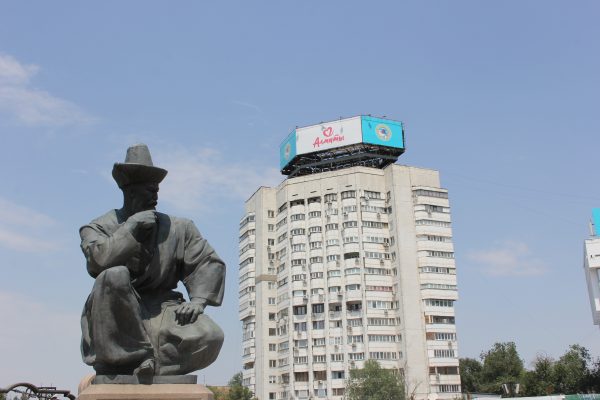By Oliver Reschreiter
Copyright thediplomat

Among its Central Asian neighbors, Kazakhstan has distinguished itself with a steady stream of green pledges on renewable energy. As far back as 2012, then-President Nursultan Nazarbayev launched the Kazakhstan-2050 Strategy, declaring that the fossil fuel era was coming to an end and setting an aspirational target of generating half of all electricity from alternative and renewable sources by 2050. To give substance to that vision, Nazarbayev issued a decree the following year adopting the Concept for Transition to a Green Economy, which established incremental goals of 3 percent renewables by 2020, 10 percent by 2030, and 50 percent by 2050. Further agenda-setting from current President Kassym-Jomart Tokayev appeared to reinforce these ambitions, with his administration in 2021 unveiling the Doctrine of Carbon Neutrality, pledging Kazakhstan would achieve net-zero emissions by 2060. Tokayev also increased the renewables target for 2030 from 10 to 15 percent. That same year, the government submitted an updated nationally determined contribution (NDC) under the U.N. Paris Agreement, committing to reduce greenhouse gas emissions by 15 percent by 2030 compared to 1990 levels. In addition, the country further signaled its commitment to renewable targets through the development of various wind, solar, and hydrogen projects, including the planned Hyrasia One hydrogen mega-project on the Caspian coast. Yet this robust framework for a green transition belies a stark reality. Fossil fuels still dominate Kazakhstan’s energy mix, supplying around 85 percent of electricity, with coal alone providing more than half. Renewable capacity has expanded in recent years, but the pace remains too modest to reach the 15 percent goal pledged for 2030. The question, then, is why such an ambitious policy framework has translated into such limited change? The answer lies not in generic petrostate inefficiency, but in a more specific structural dilemma. In the wake of independence, Kazakhstan turned to production-sharing agreements with major foreign oil companies that locked in hydrocarbon dependence for decades. That legacy, reinforced by rent-seeking elites, weak governance institutions, and ineffective policy, has systematically constrained renewables to the margins of the energy system. Locked in at Independence Kazakhstan’s hydrocarbon economic and energy consumption dependencies did not stem purely from an abundance of resources that lay in its territory; rather, this reliance was institutionalized in the 1990s. As the newly independent state faced a collapsing industrial base and an acute fiscal crisis, it lacked both the capital and technical capacity to develop its vast oil and gas reserves on its own. Nazarbayev saw attracting foreign investment in Kazakhstan’s energy sector as the most viable way to mitigate an impending economic collapse. The legal foundations to opening the country’s resource wealth were laid with the passage of the 1992 Law on Subsoil and Subsoil Use, which declared all subsoil resources state property and established a licensing and contract system for their exploration and development. Coupled with Kazakhstan’s 1993 Constitution, which broadly vested governing powers in the executive and left the separation of powers between branches poorly defined, this framework allowed Nazarbayev to negotiate directly with foreign firms with little oversight and created the basis for the long-term production sharing agreements (PSA) that continue to shape Kazakhstan’s trajectory today. The first PSA was signed in April 1993, when Nazarbayev’s government concluded an agreement with the American oil company Chevron, establishing the Tengizchevroil joint venture, and granting it the rights to produce oil from the Tengiz field. Negotiated largely behind closed doors, the 40-year contract gave Chevron a 50 percent operating stake. U.S. diplomats strongly backed the deal, and Nazarbayev viewed Chevron’s participation as critical to securing early American bilateral assistance and political support. Two more long-term PSAs followed in 1997, reinforcing the precedent Nazarbayev had established. The Karachaganak PSA, a 40-year contract with a consortium led by Agip and Shell, together with Chevron and Lukoil, granted extensive rights to one of the world’s largest gas-condensate deposits. That same year the government signed the North Caspian PSA, another 40-year pact with Eni, Shell, ExxonMobil, and Total, which later led to the 2000 discovery of the Kashagan field. Beyond the long-term concessions these PSAs granted foreign energy firms, their terms were exceptionally generous even by international standards. Cost recovery clauses let operators recoup expenses before sharing profits, while sweeping stabilization and arbitration provisions froze taxes and allowed disputes to bypass Kazakh courts, giving the contracts an autonomy that critics compared to a law of their own. Investigations by the International Consortium of Investigative Journalists describe how these contracts were negotiated with little public or parliamentary oversight and included profit-sharing formulas and local content requirements that heavily favored foreign investors. While the agreements brought the capital and recognition Nazarbayev sought, they locked Kazakhstan into dependence on oil rents and concentrated wealth and influence within a narrow circle of elites, shaping the political economy that still governs the country’s energy sector. Entrenched Elites and Conflicts of Interest The production sharing agreements of the 1990s not only locked Kazakhstan into a fossil-fuel trajectory, they also created an energy and political system dominated by a narrow circle of politically connected elites. In the decades that followed, vast oil rents became the foundation of both state finances and political power. By the late 2000s, revenues from hydrocarbons made up more than a third of gross domestic product and over 70 percent of exports, while the National Fund of Kazakhstan accumulated billions of petrodollars with limited transparency or public oversight. Much of this wealth flowed through a handful of state-owned companies, including KazMunaiGas, KEGOC, and Samruk Energy, which in 2008 were consolidated under the Samruk Kazyna sovereign wealth fund. Reporting directly to the president and key ministers, Samruk Kazyna blurred the line between regulator and market participant. Samruk Kazyna’s leadership often served as a channel of political patronage. Nazarbayev’s son-in-law Timur Kulibayev, who chaired the fund and KazMunaiGas, and mining billionaire Vladimir Kim both leveraged close ties to the presidency to build vast personal fortunes and exert significant influence in the energy sector Renewable energy was drawn into the same orbit as Kazakhstan’s fossil fuel establishment. Samruk Green Energy, a subsidiary of fossil fuel heavy Samruk Energy was formed in 2012 for the purpose of managing the funds renewable portfolio. It subsequently took the lead on Kazakhstan’s early renewable projects. Because the main developer of renewable power is owned by the same conglomerate that operates the country’s largest fossil fuel sites, decisions on tariffs, grid access and investment are shaped by interests that benefit from fossil-fuel dominance, discouraging independent competition and slowing the energy transition. Subsequent high-profile ventures reflect this pattern of keeping renewables within a state dominated fossil fuel ecosystem. Beyond the 50-megawatt Ereymentau-1 wind farm it commissioned in 2015, Samruk Energy and its affiliated subsidiaries built or co-financed projects such as the now shelved 50-megawatt Ereymentau-2 expansion, the 100-megawatt Burnoye-1 and Burnoye-2 solar plants in Zhambyl Region, and several small hydro installations in the east of the country. In addition over the past decade, Kazakhstan and Samruk Energy have courted investors from other petrostates, concluding high profile agreements with the United Arab Emirates’ Masdar for a one-gigawatt wind and battery complex and with Saudi Arabia’s ACWA Power for a similarly scaled project at the Dzungarian Gate. These Gulf-backed deals are frequently arranged through opaque intergovernmental agreements, raising concerns about transparency and reinforcing the dominance of fossil-fuel interests even within the renewable sector. Further highly publicized announcements of wind or hydrogen projects, such as the Hyrasia One hydrogen plant on the Caspian coast, are promoted as evidence of green progress but their actual feasibility remains tepid at best. Institutional changes have further reinforced these patterns rather than reforming them. In 2014 the government merged the energy and environmental agencies into a single Ministry of Energy responsible for both hydrocarbons and renewables, centralizing authority. Environmental responsibilities were spun off again in 2019 with the creation of the Ministry of Ecology, Geology, and Natural Resources, once again grouping environmental issues with the same ministry responsible for resource extraction. These weak institutional changes were mirrored in legislation where renewable targets remain nonbinding. The 2009 Law on Support for the Use of Renewable Energy Sources relied on annual government discretion, the 2013 National Concept for Transition to a Green Economy set ambitious but unenforceable goals, and the 2021 Doctrine on Achieving Carbon Neutrality outlined decarbonization targets without legal penalties. The result of all the aforementioned factors is a political economy in which fossil fuel revenues underwrite the state while the very institutions meant to drive a green transition remain dependent on those same earnings. After more than a decade of ambitious pledges, renewables make up only 6.8 percent of Kazakhstan’s power mix, and the country is on track to fall short of its own renewable energy targets. What Next? Kazakhstan’s sweeping renewable pledges project the image of a country ready to push ahead with renewable energy, yet the reality of its transition remains held back and rooted in decisions made three decades ago. PSAs with foreign oil companies in the 1990s entrenched hydrocarbon dependence and created a state reliant on oil rents. Those rents now sustain the very institutions that are supposed to guide a green transition, while a small circle of politically connected elites continues to shape energy policy around fossil fuels. Renewable projects provide international visibility, yet they function more as a performance of modernization than as a challenge to the rent-based political system that underpins the economy. In the present, a slow shift may be possible. Several of the 1990s era PSAs, including those at Tengiz, Karachaganak, and the North Caspian Sea, are moving toward expiry, and the state is already engaged in high stakes arbitration with the international firms that control Kazakhstan’s vast oil and gas reserves. Their eventual renegotiation offers Tokayev and any future successor a rare opportunity to end the Nazarbayev legacy of de facto foreign control in the fossil fuel industry, redirect resource revenues, strengthen independent regulation, and create room for a more credible renewable strategy. Whether that potential is realized depends on Tokayev’s willingness to dismantle the main inhibitors of a genuine transition, including the powerful Samruk Kazyna holding and the façade of independent renewable development that in practice remains tied to state-owned, fossil-fuel-dominated interests Whether Kazakhstan can seize this moment is uncertain. What is certain, however, is that without decisive moves to build transparent institutions and reduce reliance on fossil rents, the country’s green agenda will remain largely symbolic and hydrocarbons will continue to dominate its economy. For potential external partners such as the European Union, such performative legislation will need to be addressed should Kazakhstan wish to become the sustainable partner it claims itself to be and the EU wishes it to be.



